NURS1008: Deconstructing Perspectives on Indigenous Health Issues
VerifiedAdded on 2023/06/07
|11
|3272
|265
Essay
AI Summary
This essay deconstructs the question, "Why don’t Aboriginal people take an interest in their own health?" by examining the underlying assumptions, historical context, and social determinants of health affecting Indigenous Australians. It critiques the insensitive viewpoint often held by non-Indigenous individuals, highlighting the impact of discrimination, racism, and historical exploitation on the health outcomes of Aboriginal communities. The essay explores the lack of cultural awareness and the ignorance of the historical injustices faced by Indigenous populations, including dispossession, violence, and the introduction of diseases. It emphasizes the need for culturally sensitive healthcare and addresses the disparities in education, employment, and socioeconomic status that contribute to poor health outcomes. The essay concludes by advocating for nursing interventions to improve the social determinants of health and enhance the quality of life for Indigenous Australians.
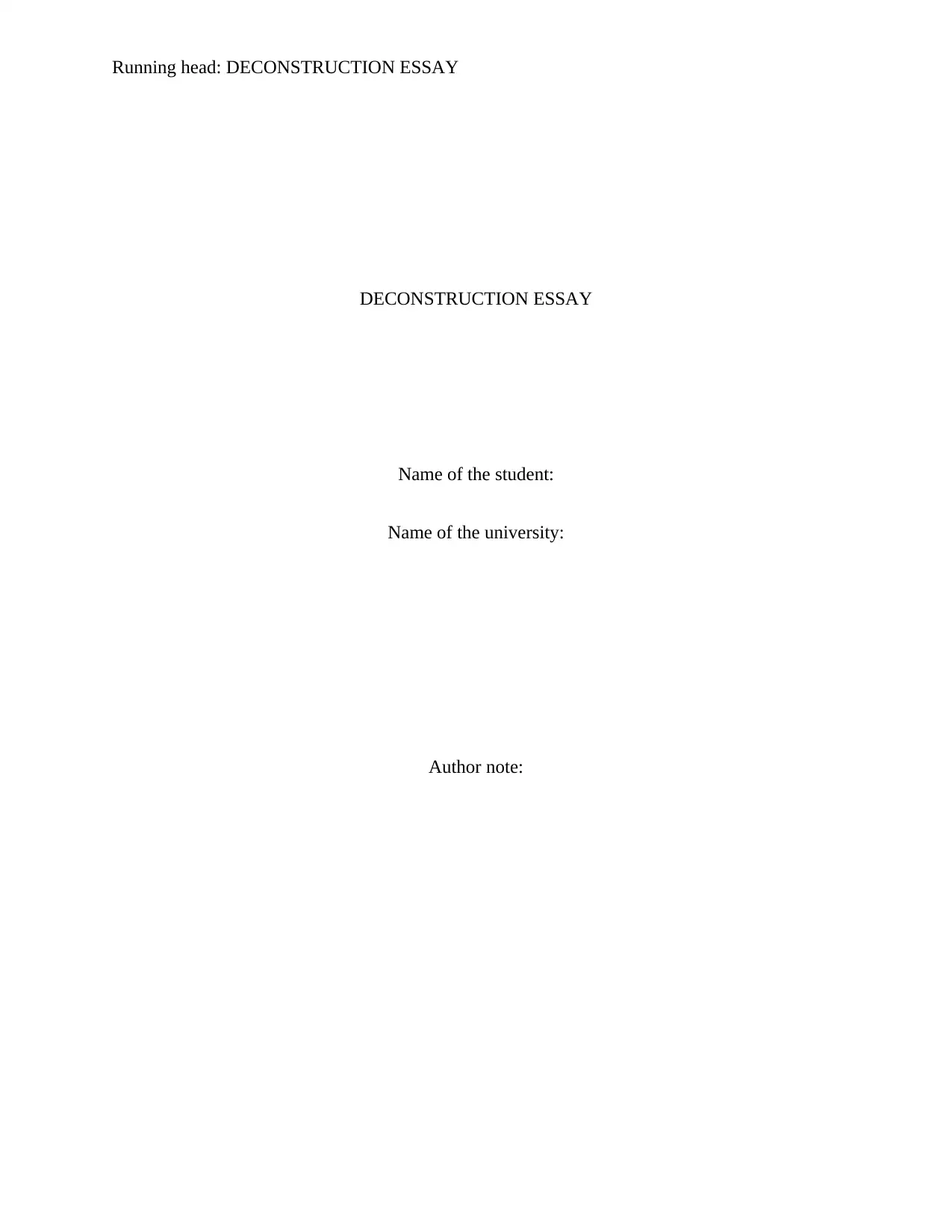
Running head: DECONSTRUCTION ESSAY
DECONSTRUCTION ESSAY
Name of the student:
Name of the university:
Author note:
DECONSTRUCTION ESSAY
Name of the student:
Name of the university:
Author note:
Paraphrase This Document
Need a fresh take? Get an instant paraphrase of this document with our AI Paraphraser
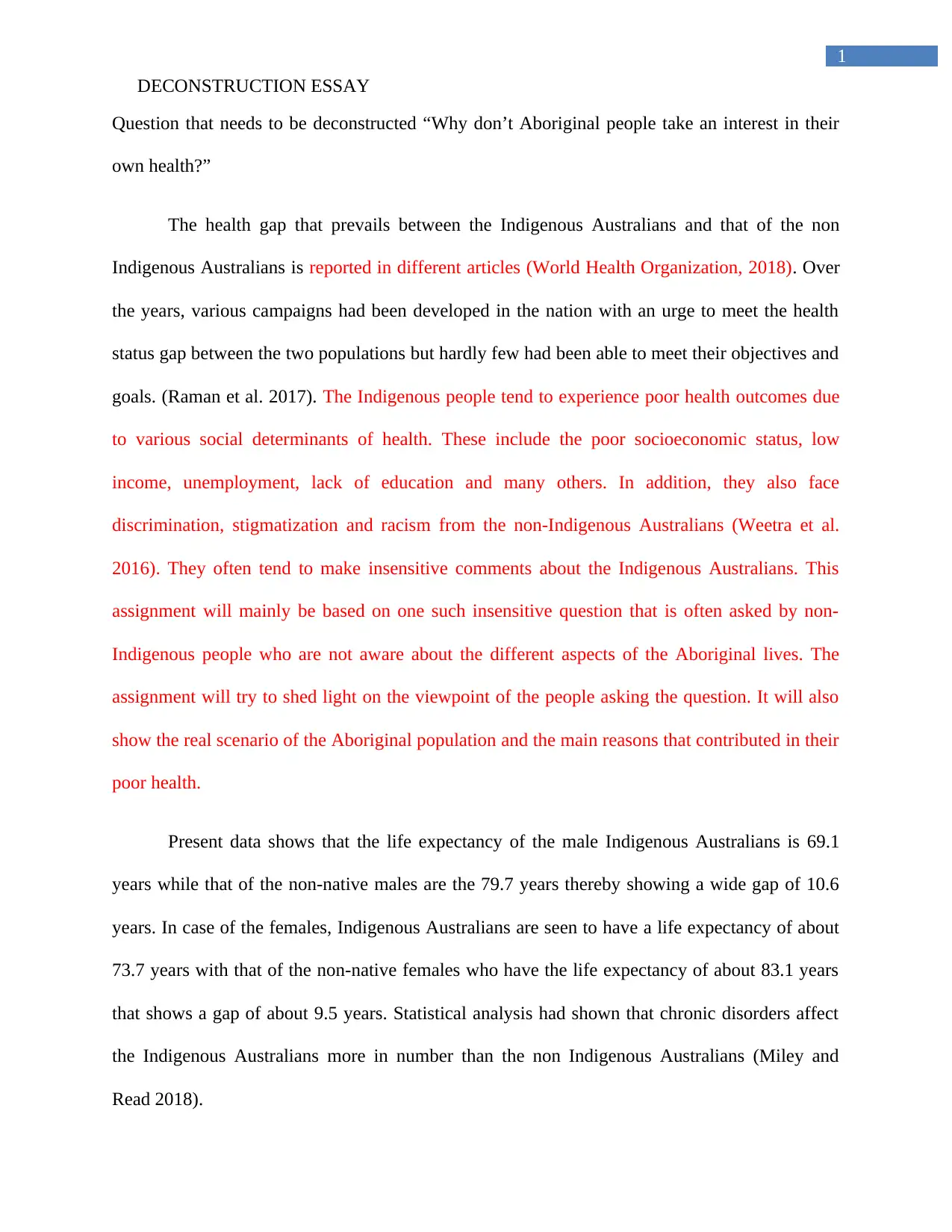
1
DECONSTRUCTION ESSAY
Question that needs to be deconstructed “Why don’t Aboriginal people take an interest in their
own health?”
The health gap that prevails between the Indigenous Australians and that of the non
Indigenous Australians is reported in different articles (World Health Organization, 2018). Over
the years, various campaigns had been developed in the nation with an urge to meet the health
status gap between the two populations but hardly few had been able to meet their objectives and
goals. (Raman et al. 2017). The Indigenous people tend to experience poor health outcomes due
to various social determinants of health. These include the poor socioeconomic status, low
income, unemployment, lack of education and many others. In addition, they also face
discrimination, stigmatization and racism from the non-Indigenous Australians (Weetra et al.
2016). They often tend to make insensitive comments about the Indigenous Australians. This
assignment will mainly be based on one such insensitive question that is often asked by non-
Indigenous people who are not aware about the different aspects of the Aboriginal lives. The
assignment will try to shed light on the viewpoint of the people asking the question. It will also
show the real scenario of the Aboriginal population and the main reasons that contributed in their
poor health.
Present data shows that the life expectancy of the male Indigenous Australians is 69.1
years while that of the non-native males are the 79.7 years thereby showing a wide gap of 10.6
years. In case of the females, Indigenous Australians are seen to have a life expectancy of about
73.7 years with that of the non-native females who have the life expectancy of about 83.1 years
that shows a gap of about 9.5 years. Statistical analysis had shown that chronic disorders affect
the Indigenous Australians more in number than the non Indigenous Australians (Miley and
Read 2018).
DECONSTRUCTION ESSAY
Question that needs to be deconstructed “Why don’t Aboriginal people take an interest in their
own health?”
The health gap that prevails between the Indigenous Australians and that of the non
Indigenous Australians is reported in different articles (World Health Organization, 2018). Over
the years, various campaigns had been developed in the nation with an urge to meet the health
status gap between the two populations but hardly few had been able to meet their objectives and
goals. (Raman et al. 2017). The Indigenous people tend to experience poor health outcomes due
to various social determinants of health. These include the poor socioeconomic status, low
income, unemployment, lack of education and many others. In addition, they also face
discrimination, stigmatization and racism from the non-Indigenous Australians (Weetra et al.
2016). They often tend to make insensitive comments about the Indigenous Australians. This
assignment will mainly be based on one such insensitive question that is often asked by non-
Indigenous people who are not aware about the different aspects of the Aboriginal lives. The
assignment will try to shed light on the viewpoint of the people asking the question. It will also
show the real scenario of the Aboriginal population and the main reasons that contributed in their
poor health.
Present data shows that the life expectancy of the male Indigenous Australians is 69.1
years while that of the non-native males are the 79.7 years thereby showing a wide gap of 10.6
years. In case of the females, Indigenous Australians are seen to have a life expectancy of about
73.7 years with that of the non-native females who have the life expectancy of about 83.1 years
that shows a gap of about 9.5 years. Statistical analysis had shown that chronic disorders affect
the Indigenous Australians more in number than the non Indigenous Australians (Miley and
Read 2018).
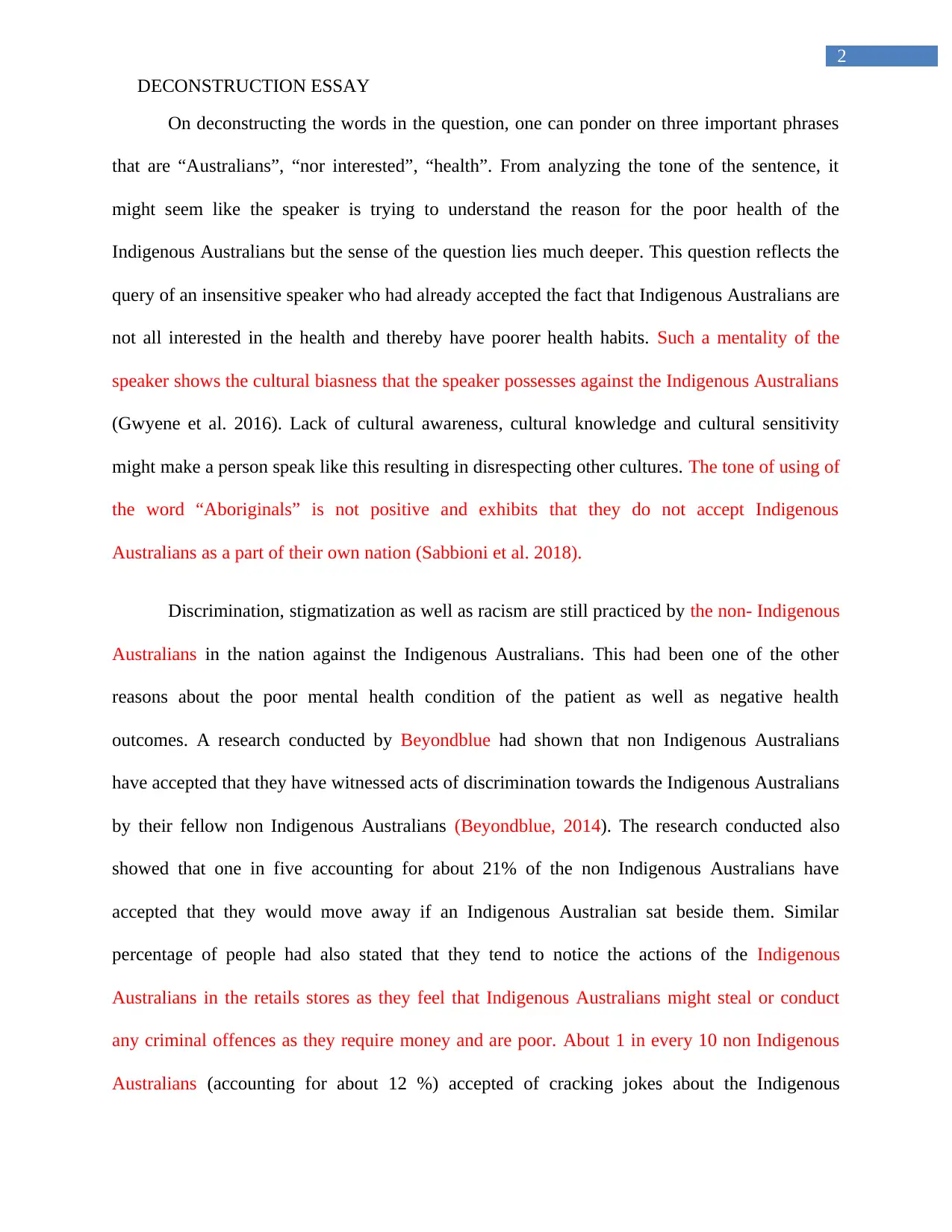
2
DECONSTRUCTION ESSAY
On deconstructing the words in the question, one can ponder on three important phrases
that are “Australians”, “nor interested”, “health”. From analyzing the tone of the sentence, it
might seem like the speaker is trying to understand the reason for the poor health of the
Indigenous Australians but the sense of the question lies much deeper. This question reflects the
query of an insensitive speaker who had already accepted the fact that Indigenous Australians are
not all interested in the health and thereby have poorer health habits. Such a mentality of the
speaker shows the cultural biasness that the speaker possesses against the Indigenous Australians
(Gwyene et al. 2016). Lack of cultural awareness, cultural knowledge and cultural sensitivity
might make a person speak like this resulting in disrespecting other cultures. The tone of using of
the word “Aboriginals” is not positive and exhibits that they do not accept Indigenous
Australians as a part of their own nation (Sabbioni et al. 2018).
Discrimination, stigmatization as well as racism are still practiced by the non- Indigenous
Australians in the nation against the Indigenous Australians. This had been one of the other
reasons about the poor mental health condition of the patient as well as negative health
outcomes. A research conducted by Beyondblue had shown that non Indigenous Australians
have accepted that they have witnessed acts of discrimination towards the Indigenous Australians
by their fellow non Indigenous Australians (Beyondblue, 2014). The research conducted also
showed that one in five accounting for about 21% of the non Indigenous Australians have
accepted that they would move away if an Indigenous Australian sat beside them. Similar
percentage of people had also stated that they tend to notice the actions of the Indigenous
Australians in the retails stores as they feel that Indigenous Australians might steal or conduct
any criminal offences as they require money and are poor. About 1 in every 10 non Indigenous
Australians (accounting for about 12 %) accepted of cracking jokes about the Indigenous
DECONSTRUCTION ESSAY
On deconstructing the words in the question, one can ponder on three important phrases
that are “Australians”, “nor interested”, “health”. From analyzing the tone of the sentence, it
might seem like the speaker is trying to understand the reason for the poor health of the
Indigenous Australians but the sense of the question lies much deeper. This question reflects the
query of an insensitive speaker who had already accepted the fact that Indigenous Australians are
not all interested in the health and thereby have poorer health habits. Such a mentality of the
speaker shows the cultural biasness that the speaker possesses against the Indigenous Australians
(Gwyene et al. 2016). Lack of cultural awareness, cultural knowledge and cultural sensitivity
might make a person speak like this resulting in disrespecting other cultures. The tone of using of
the word “Aboriginals” is not positive and exhibits that they do not accept Indigenous
Australians as a part of their own nation (Sabbioni et al. 2018).
Discrimination, stigmatization as well as racism are still practiced by the non- Indigenous
Australians in the nation against the Indigenous Australians. This had been one of the other
reasons about the poor mental health condition of the patient as well as negative health
outcomes. A research conducted by Beyondblue had shown that non Indigenous Australians
have accepted that they have witnessed acts of discrimination towards the Indigenous Australians
by their fellow non Indigenous Australians (Beyondblue, 2014). The research conducted also
showed that one in five accounting for about 21% of the non Indigenous Australians have
accepted that they would move away if an Indigenous Australian sat beside them. Similar
percentage of people had also stated that they tend to notice the actions of the Indigenous
Australians in the retails stores as they feel that Indigenous Australians might steal or conduct
any criminal offences as they require money and are poor. About 1 in every 10 non Indigenous
Australians (accounting for about 12 %) accepted of cracking jokes about the Indigenous
⊘ This is a preview!⊘
Do you want full access?
Subscribe today to unlock all pages.

Trusted by 1+ million students worldwide
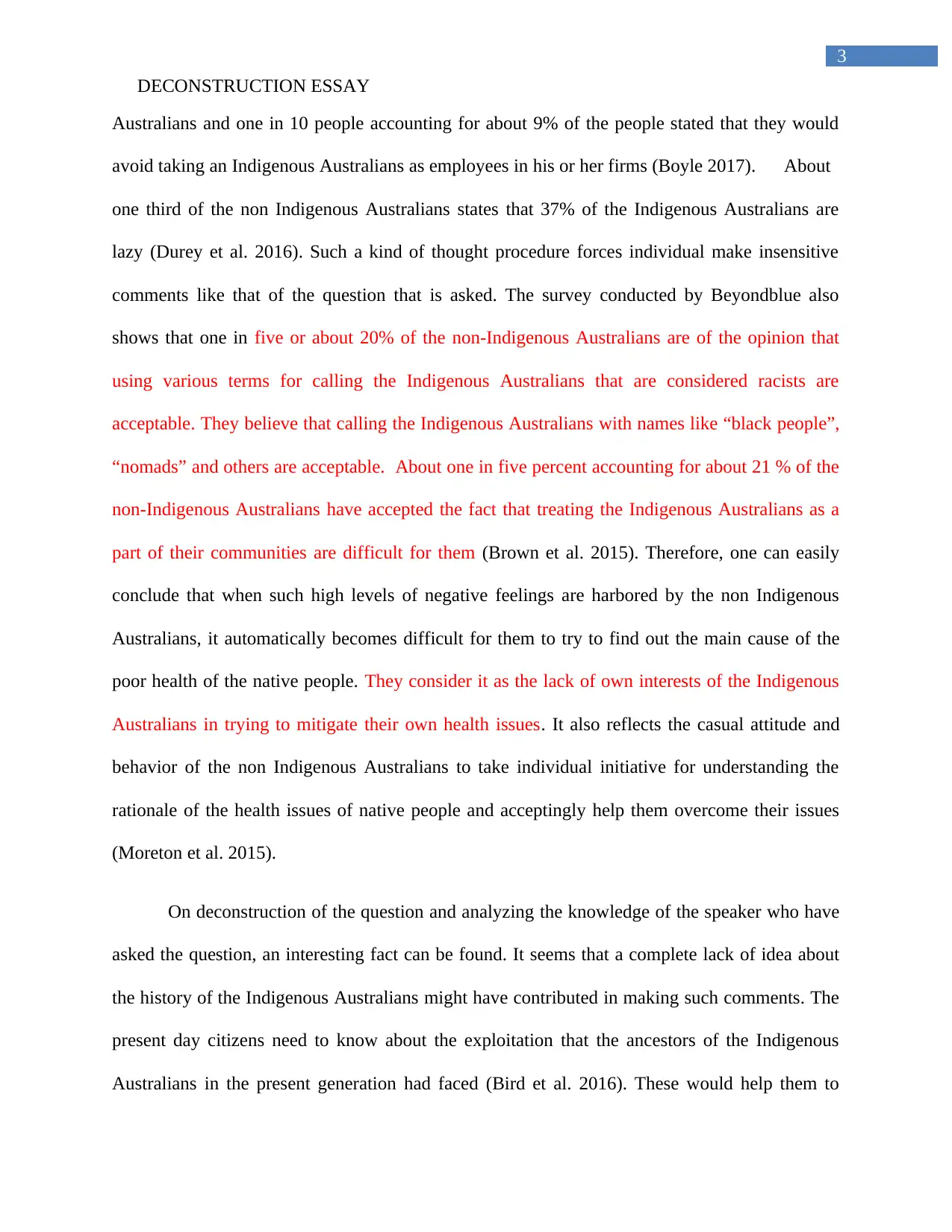
3
DECONSTRUCTION ESSAY
Australians and one in 10 people accounting for about 9% of the people stated that they would
avoid taking an Indigenous Australians as employees in his or her firms (Boyle 2017). About
one third of the non Indigenous Australians states that 37% of the Indigenous Australians are
lazy (Durey et al. 2016). Such a kind of thought procedure forces individual make insensitive
comments like that of the question that is asked. The survey conducted by Beyondblue also
shows that one in five or about 20% of the non-Indigenous Australians are of the opinion that
using various terms for calling the Indigenous Australians that are considered racists are
acceptable. They believe that calling the Indigenous Australians with names like “black people”,
“nomads” and others are acceptable. About one in five percent accounting for about 21 % of the
non-Indigenous Australians have accepted the fact that treating the Indigenous Australians as a
part of their communities are difficult for them (Brown et al. 2015). Therefore, one can easily
conclude that when such high levels of negative feelings are harbored by the non Indigenous
Australians, it automatically becomes difficult for them to try to find out the main cause of the
poor health of the native people. They consider it as the lack of own interests of the Indigenous
Australians in trying to mitigate their own health issues. It also reflects the casual attitude and
behavior of the non Indigenous Australians to take individual initiative for understanding the
rationale of the health issues of native people and acceptingly help them overcome their issues
(Moreton et al. 2015).
On deconstruction of the question and analyzing the knowledge of the speaker who have
asked the question, an interesting fact can be found. It seems that a complete lack of idea about
the history of the Indigenous Australians might have contributed in making such comments. The
present day citizens need to know about the exploitation that the ancestors of the Indigenous
Australians in the present generation had faced (Bird et al. 2016). These would help them to
DECONSTRUCTION ESSAY
Australians and one in 10 people accounting for about 9% of the people stated that they would
avoid taking an Indigenous Australians as employees in his or her firms (Boyle 2017). About
one third of the non Indigenous Australians states that 37% of the Indigenous Australians are
lazy (Durey et al. 2016). Such a kind of thought procedure forces individual make insensitive
comments like that of the question that is asked. The survey conducted by Beyondblue also
shows that one in five or about 20% of the non-Indigenous Australians are of the opinion that
using various terms for calling the Indigenous Australians that are considered racists are
acceptable. They believe that calling the Indigenous Australians with names like “black people”,
“nomads” and others are acceptable. About one in five percent accounting for about 21 % of the
non-Indigenous Australians have accepted the fact that treating the Indigenous Australians as a
part of their communities are difficult for them (Brown et al. 2015). Therefore, one can easily
conclude that when such high levels of negative feelings are harbored by the non Indigenous
Australians, it automatically becomes difficult for them to try to find out the main cause of the
poor health of the native people. They consider it as the lack of own interests of the Indigenous
Australians in trying to mitigate their own health issues. It also reflects the casual attitude and
behavior of the non Indigenous Australians to take individual initiative for understanding the
rationale of the health issues of native people and acceptingly help them overcome their issues
(Moreton et al. 2015).
On deconstruction of the question and analyzing the knowledge of the speaker who have
asked the question, an interesting fact can be found. It seems that a complete lack of idea about
the history of the Indigenous Australians might have contributed in making such comments. The
present day citizens need to know about the exploitation that the ancestors of the Indigenous
Australians in the present generation had faced (Bird et al. 2016). These would help them to
Paraphrase This Document
Need a fresh take? Get an instant paraphrase of this document with our AI Paraphraser
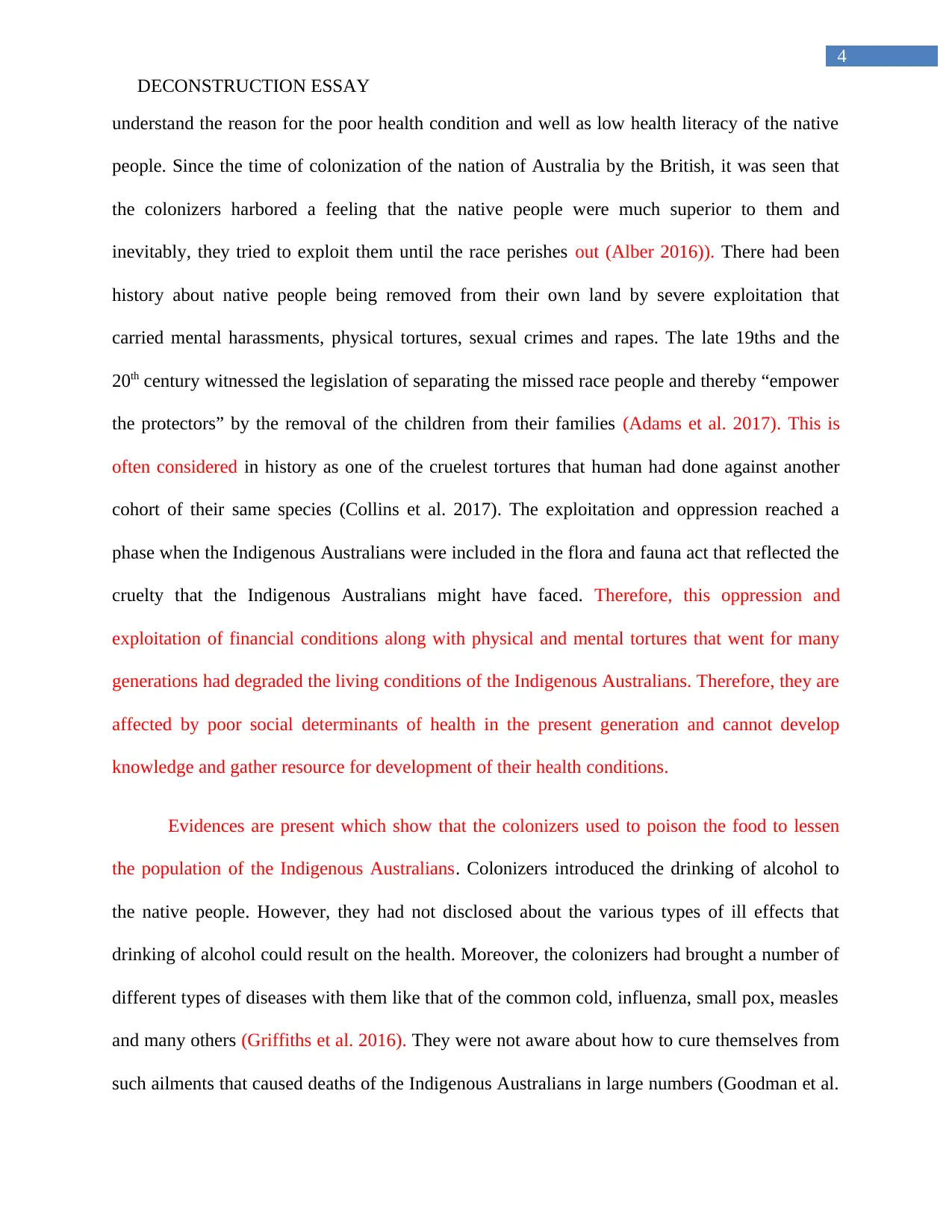
4
DECONSTRUCTION ESSAY
understand the reason for the poor health condition and well as low health literacy of the native
people. Since the time of colonization of the nation of Australia by the British, it was seen that
the colonizers harbored a feeling that the native people were much superior to them and
inevitably, they tried to exploit them until the race perishes out (Alber 2016)). There had been
history about native people being removed from their own land by severe exploitation that
carried mental harassments, physical tortures, sexual crimes and rapes. The late 19ths and the
20th century witnessed the legislation of separating the missed race people and thereby “empower
the protectors” by the removal of the children from their families (Adams et al. 2017). This is
often considered in history as one of the cruelest tortures that human had done against another
cohort of their same species (Collins et al. 2017). The exploitation and oppression reached a
phase when the Indigenous Australians were included in the flora and fauna act that reflected the
cruelty that the Indigenous Australians might have faced. Therefore, this oppression and
exploitation of financial conditions along with physical and mental tortures that went for many
generations had degraded the living conditions of the Indigenous Australians. Therefore, they are
affected by poor social determinants of health in the present generation and cannot develop
knowledge and gather resource for development of their health conditions.
Evidences are present which show that the colonizers used to poison the food to lessen
the population of the Indigenous Australians. Colonizers introduced the drinking of alcohol to
the native people. However, they had not disclosed about the various types of ill effects that
drinking of alcohol could result on the health. Moreover, the colonizers had brought a number of
different types of diseases with them like that of the common cold, influenza, small pox, measles
and many others (Griffiths et al. 2016). They were not aware about how to cure themselves from
such ailments that caused deaths of the Indigenous Australians in large numbers (Goodman et al.
DECONSTRUCTION ESSAY
understand the reason for the poor health condition and well as low health literacy of the native
people. Since the time of colonization of the nation of Australia by the British, it was seen that
the colonizers harbored a feeling that the native people were much superior to them and
inevitably, they tried to exploit them until the race perishes out (Alber 2016)). There had been
history about native people being removed from their own land by severe exploitation that
carried mental harassments, physical tortures, sexual crimes and rapes. The late 19ths and the
20th century witnessed the legislation of separating the missed race people and thereby “empower
the protectors” by the removal of the children from their families (Adams et al. 2017). This is
often considered in history as one of the cruelest tortures that human had done against another
cohort of their same species (Collins et al. 2017). The exploitation and oppression reached a
phase when the Indigenous Australians were included in the flora and fauna act that reflected the
cruelty that the Indigenous Australians might have faced. Therefore, this oppression and
exploitation of financial conditions along with physical and mental tortures that went for many
generations had degraded the living conditions of the Indigenous Australians. Therefore, they are
affected by poor social determinants of health in the present generation and cannot develop
knowledge and gather resource for development of their health conditions.
Evidences are present which show that the colonizers used to poison the food to lessen
the population of the Indigenous Australians. Colonizers introduced the drinking of alcohol to
the native people. However, they had not disclosed about the various types of ill effects that
drinking of alcohol could result on the health. Moreover, the colonizers had brought a number of
different types of diseases with them like that of the common cold, influenza, small pox, measles
and many others (Griffiths et al. 2016). They were not aware about how to cure themselves from
such ailments that caused deaths of the Indigenous Australians in large numbers (Goodman et al.
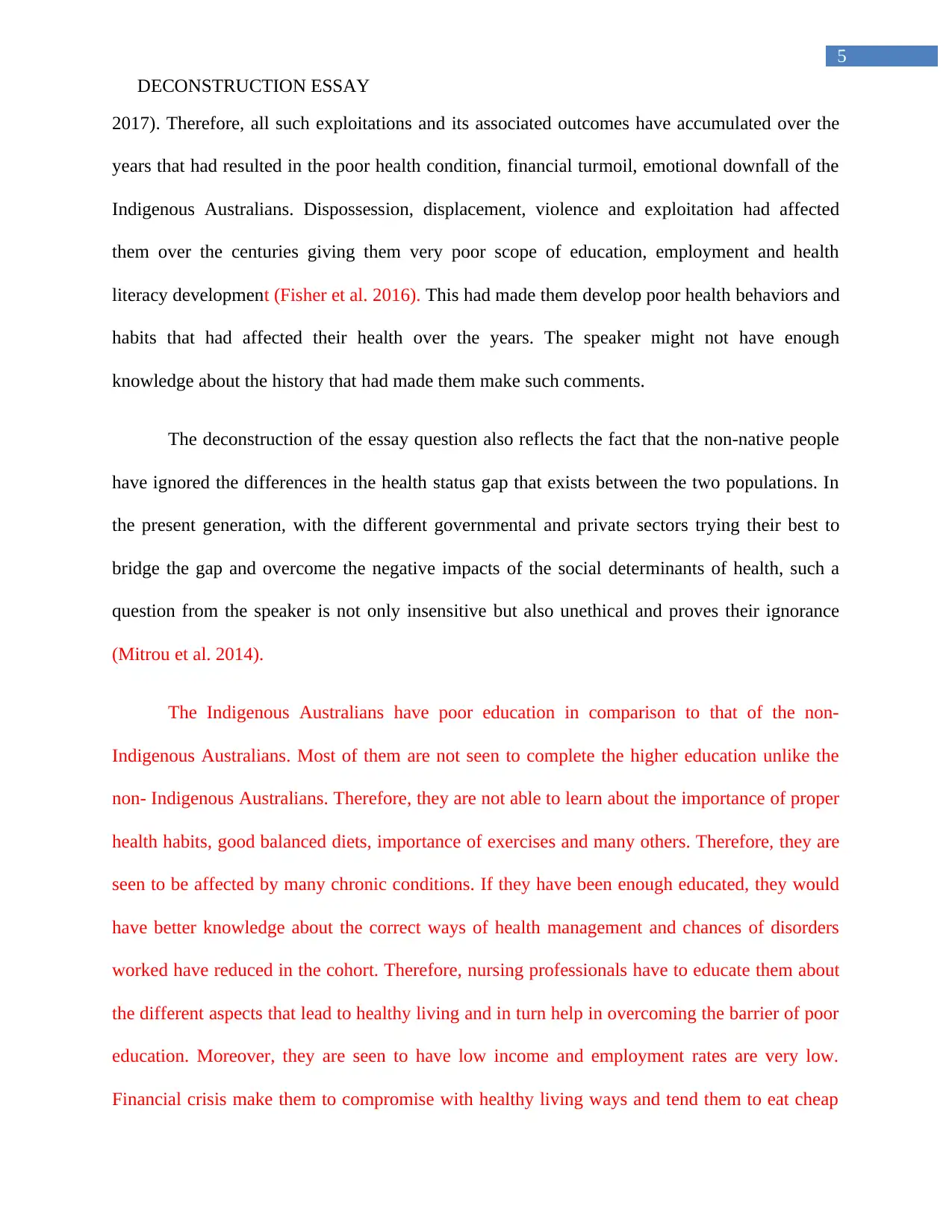
5
DECONSTRUCTION ESSAY
2017). Therefore, all such exploitations and its associated outcomes have accumulated over the
years that had resulted in the poor health condition, financial turmoil, emotional downfall of the
Indigenous Australians. Dispossession, displacement, violence and exploitation had affected
them over the centuries giving them very poor scope of education, employment and health
literacy development (Fisher et al. 2016). This had made them develop poor health behaviors and
habits that had affected their health over the years. The speaker might not have enough
knowledge about the history that had made them make such comments.
The deconstruction of the essay question also reflects the fact that the non-native people
have ignored the differences in the health status gap that exists between the two populations. In
the present generation, with the different governmental and private sectors trying their best to
bridge the gap and overcome the negative impacts of the social determinants of health, such a
question from the speaker is not only insensitive but also unethical and proves their ignorance
(Mitrou et al. 2014).
The Indigenous Australians have poor education in comparison to that of the non-
Indigenous Australians. Most of them are not seen to complete the higher education unlike the
non- Indigenous Australians. Therefore, they are not able to learn about the importance of proper
health habits, good balanced diets, importance of exercises and many others. Therefore, they are
seen to be affected by many chronic conditions. If they have been enough educated, they would
have better knowledge about the correct ways of health management and chances of disorders
worked have reduced in the cohort. Therefore, nursing professionals have to educate them about
the different aspects that lead to healthy living and in turn help in overcoming the barrier of poor
education. Moreover, they are seen to have low income and employment rates are very low.
Financial crisis make them to compromise with healthy living ways and tend them to eat cheap
DECONSTRUCTION ESSAY
2017). Therefore, all such exploitations and its associated outcomes have accumulated over the
years that had resulted in the poor health condition, financial turmoil, emotional downfall of the
Indigenous Australians. Dispossession, displacement, violence and exploitation had affected
them over the centuries giving them very poor scope of education, employment and health
literacy development (Fisher et al. 2016). This had made them develop poor health behaviors and
habits that had affected their health over the years. The speaker might not have enough
knowledge about the history that had made them make such comments.
The deconstruction of the essay question also reflects the fact that the non-native people
have ignored the differences in the health status gap that exists between the two populations. In
the present generation, with the different governmental and private sectors trying their best to
bridge the gap and overcome the negative impacts of the social determinants of health, such a
question from the speaker is not only insensitive but also unethical and proves their ignorance
(Mitrou et al. 2014).
The Indigenous Australians have poor education in comparison to that of the non-
Indigenous Australians. Most of them are not seen to complete the higher education unlike the
non- Indigenous Australians. Therefore, they are not able to learn about the importance of proper
health habits, good balanced diets, importance of exercises and many others. Therefore, they are
seen to be affected by many chronic conditions. If they have been enough educated, they would
have better knowledge about the correct ways of health management and chances of disorders
worked have reduced in the cohort. Therefore, nursing professionals have to educate them about
the different aspects that lead to healthy living and in turn help in overcoming the barrier of poor
education. Moreover, they are seen to have low income and employment rates are very low.
Financial crisis make them to compromise with healthy living ways and tend them to eat cheap
⊘ This is a preview!⊘
Do you want full access?
Subscribe today to unlock all pages.

Trusted by 1+ million students worldwide
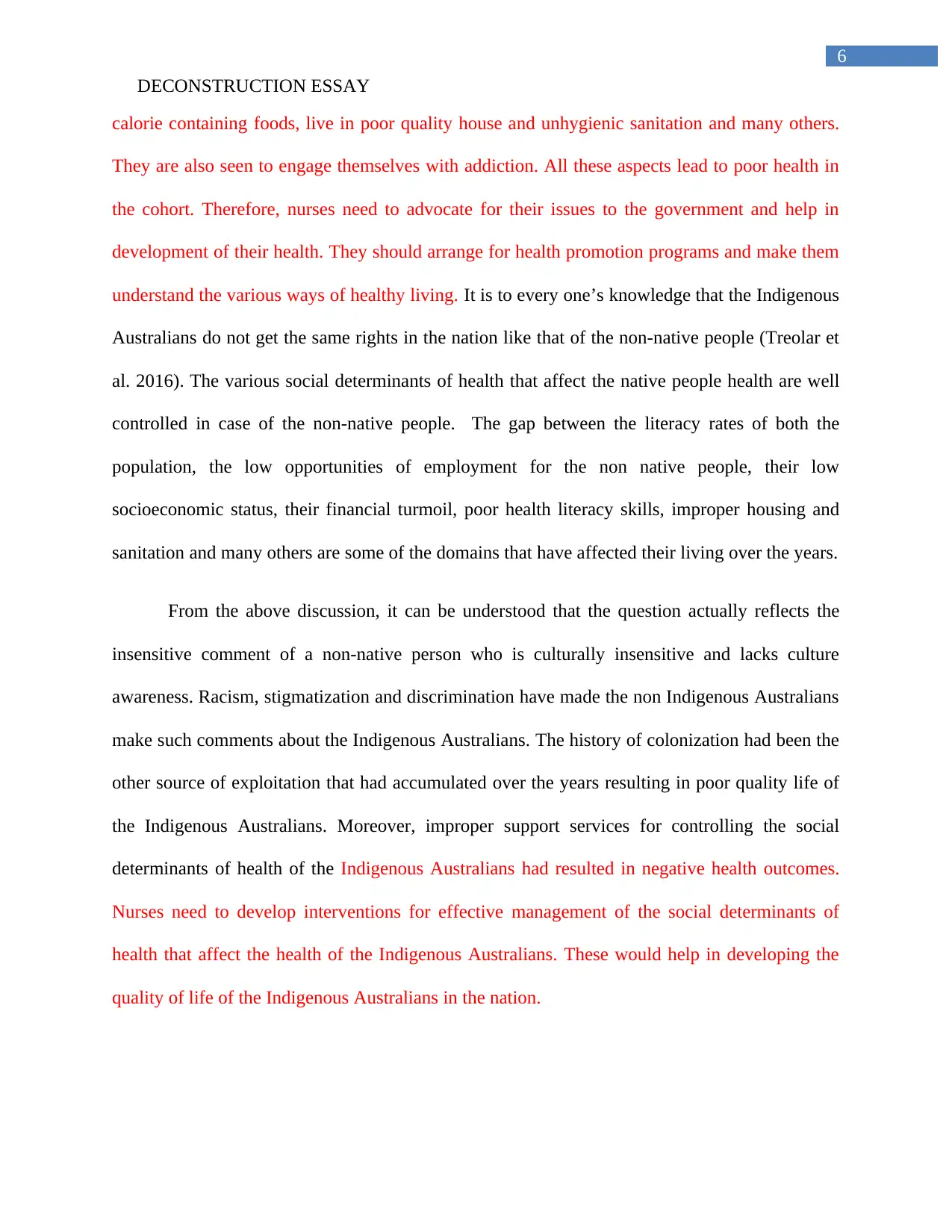
6
DECONSTRUCTION ESSAY
calorie containing foods, live in poor quality house and unhygienic sanitation and many others.
They are also seen to engage themselves with addiction. All these aspects lead to poor health in
the cohort. Therefore, nurses need to advocate for their issues to the government and help in
development of their health. They should arrange for health promotion programs and make them
understand the various ways of healthy living. It is to every one’s knowledge that the Indigenous
Australians do not get the same rights in the nation like that of the non-native people (Treolar et
al. 2016). The various social determinants of health that affect the native people health are well
controlled in case of the non-native people. The gap between the literacy rates of both the
population, the low opportunities of employment for the non native people, their low
socioeconomic status, their financial turmoil, poor health literacy skills, improper housing and
sanitation and many others are some of the domains that have affected their living over the years.
From the above discussion, it can be understood that the question actually reflects the
insensitive comment of a non-native person who is culturally insensitive and lacks culture
awareness. Racism, stigmatization and discrimination have made the non Indigenous Australians
make such comments about the Indigenous Australians. The history of colonization had been the
other source of exploitation that had accumulated over the years resulting in poor quality life of
the Indigenous Australians. Moreover, improper support services for controlling the social
determinants of health of the Indigenous Australians had resulted in negative health outcomes.
Nurses need to develop interventions for effective management of the social determinants of
health that affect the health of the Indigenous Australians. These would help in developing the
quality of life of the Indigenous Australians in the nation.
DECONSTRUCTION ESSAY
calorie containing foods, live in poor quality house and unhygienic sanitation and many others.
They are also seen to engage themselves with addiction. All these aspects lead to poor health in
the cohort. Therefore, nurses need to advocate for their issues to the government and help in
development of their health. They should arrange for health promotion programs and make them
understand the various ways of healthy living. It is to every one’s knowledge that the Indigenous
Australians do not get the same rights in the nation like that of the non-native people (Treolar et
al. 2016). The various social determinants of health that affect the native people health are well
controlled in case of the non-native people. The gap between the literacy rates of both the
population, the low opportunities of employment for the non native people, their low
socioeconomic status, their financial turmoil, poor health literacy skills, improper housing and
sanitation and many others are some of the domains that have affected their living over the years.
From the above discussion, it can be understood that the question actually reflects the
insensitive comment of a non-native person who is culturally insensitive and lacks culture
awareness. Racism, stigmatization and discrimination have made the non Indigenous Australians
make such comments about the Indigenous Australians. The history of colonization had been the
other source of exploitation that had accumulated over the years resulting in poor quality life of
the Indigenous Australians. Moreover, improper support services for controlling the social
determinants of health of the Indigenous Australians had resulted in negative health outcomes.
Nurses need to develop interventions for effective management of the social determinants of
health that affect the health of the Indigenous Australians. These would help in developing the
quality of life of the Indigenous Australians in the nation.
Paraphrase This Document
Need a fresh take? Get an instant paraphrase of this document with our AI Paraphraser
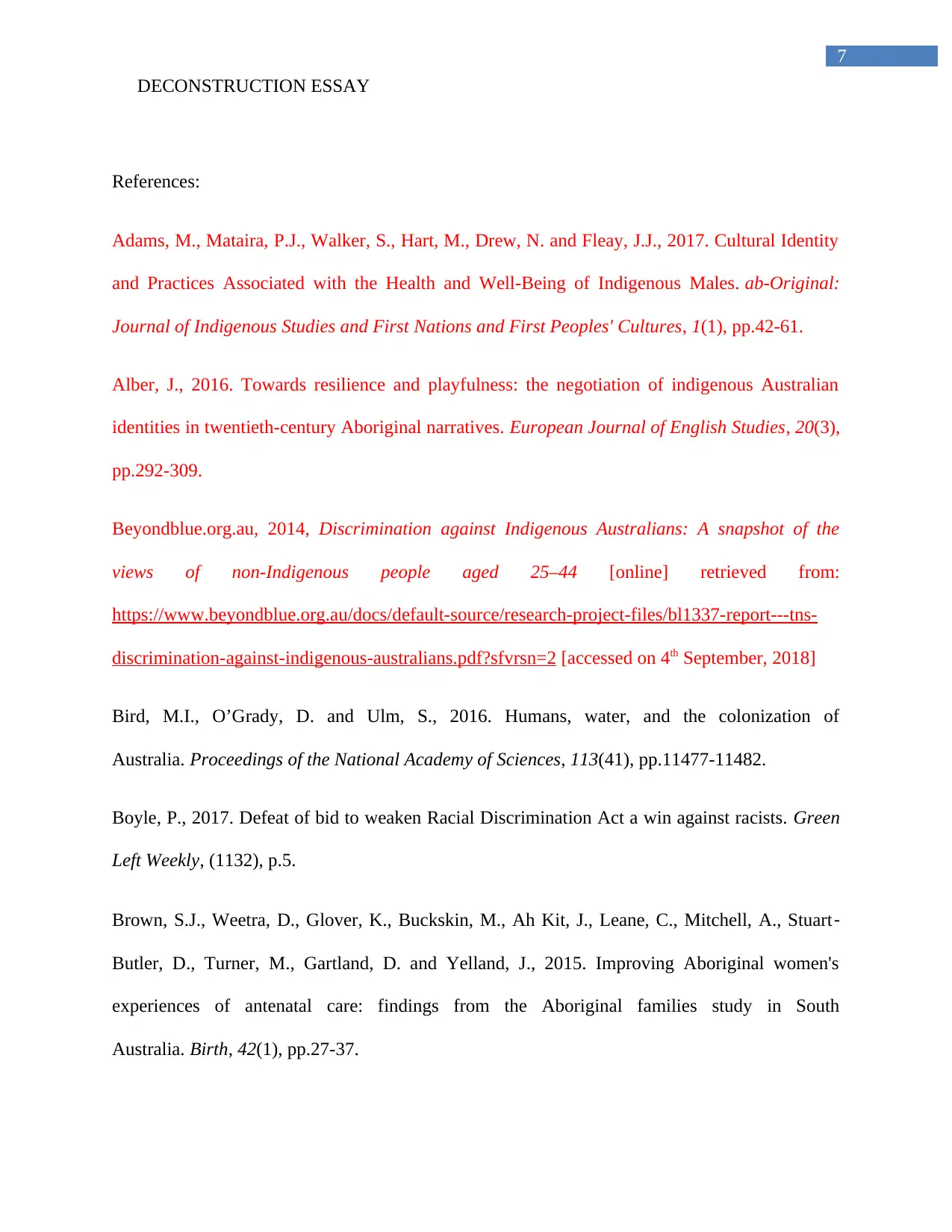
7
DECONSTRUCTION ESSAY
References:
Adams, M., Mataira, P.J., Walker, S., Hart, M., Drew, N. and Fleay, J.J., 2017. Cultural Identity
and Practices Associated with the Health and Well-Being of Indigenous Males. ab-Original:
Journal of Indigenous Studies and First Nations and First Peoples' Cultures, 1(1), pp.42-61.
Alber, J., 2016. Towards resilience and playfulness: the negotiation of indigenous Australian
identities in twentieth-century Aboriginal narratives. European Journal of English Studies, 20(3),
pp.292-309.
Beyondblue.org.au, 2014, Discrimination against Indigenous Australians: A snapshot of the
views of non-Indigenous people aged 25–44 [online] retrieved from:
https://www.beyondblue.org.au/docs/default-source/research-project-files/bl1337-report---tns-
discrimination-against-indigenous-australians.pdf?sfvrsn=2 [accessed on 4th September, 2018]
Bird, M.I., O’Grady, D. and Ulm, S., 2016. Humans, water, and the colonization of
Australia. Proceedings of the National Academy of Sciences, 113(41), pp.11477-11482.
Boyle, P., 2017. Defeat of bid to weaken Racial Discrimination Act a win against racists. Green
Left Weekly, (1132), p.5.
Brown, S.J., Weetra, D., Glover, K., Buckskin, M., Ah Kit, J., Leane, C., Mitchell, A., Stuart‐
Butler, D., Turner, M., Gartland, D. and Yelland, J., 2015. Improving Aboriginal women's
experiences of antenatal care: findings from the Aboriginal families study in South
Australia. Birth, 42(1), pp.27-37.
DECONSTRUCTION ESSAY
References:
Adams, M., Mataira, P.J., Walker, S., Hart, M., Drew, N. and Fleay, J.J., 2017. Cultural Identity
and Practices Associated with the Health and Well-Being of Indigenous Males. ab-Original:
Journal of Indigenous Studies and First Nations and First Peoples' Cultures, 1(1), pp.42-61.
Alber, J., 2016. Towards resilience and playfulness: the negotiation of indigenous Australian
identities in twentieth-century Aboriginal narratives. European Journal of English Studies, 20(3),
pp.292-309.
Beyondblue.org.au, 2014, Discrimination against Indigenous Australians: A snapshot of the
views of non-Indigenous people aged 25–44 [online] retrieved from:
https://www.beyondblue.org.au/docs/default-source/research-project-files/bl1337-report---tns-
discrimination-against-indigenous-australians.pdf?sfvrsn=2 [accessed on 4th September, 2018]
Bird, M.I., O’Grady, D. and Ulm, S., 2016. Humans, water, and the colonization of
Australia. Proceedings of the National Academy of Sciences, 113(41), pp.11477-11482.
Boyle, P., 2017. Defeat of bid to weaken Racial Discrimination Act a win against racists. Green
Left Weekly, (1132), p.5.
Brown, S.J., Weetra, D., Glover, K., Buckskin, M., Ah Kit, J., Leane, C., Mitchell, A., Stuart‐
Butler, D., Turner, M., Gartland, D. and Yelland, J., 2015. Improving Aboriginal women's
experiences of antenatal care: findings from the Aboriginal families study in South
Australia. Birth, 42(1), pp.27-37.
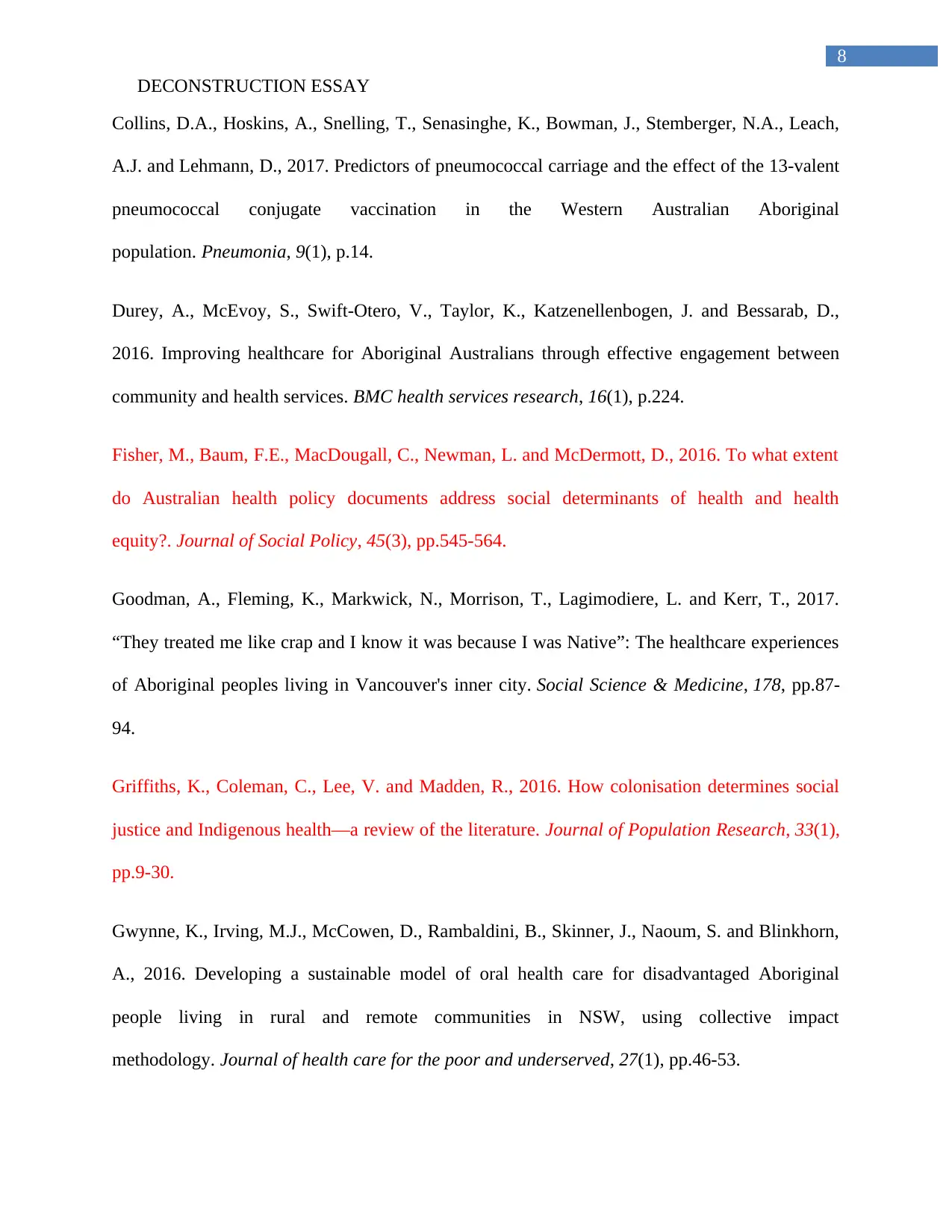
8
DECONSTRUCTION ESSAY
Collins, D.A., Hoskins, A., Snelling, T., Senasinghe, K., Bowman, J., Stemberger, N.A., Leach,
A.J. and Lehmann, D., 2017. Predictors of pneumococcal carriage and the effect of the 13-valent
pneumococcal conjugate vaccination in the Western Australian Aboriginal
population. Pneumonia, 9(1), p.14.
Durey, A., McEvoy, S., Swift-Otero, V., Taylor, K., Katzenellenbogen, J. and Bessarab, D.,
2016. Improving healthcare for Aboriginal Australians through effective engagement between
community and health services. BMC health services research, 16(1), p.224.
Fisher, M., Baum, F.E., MacDougall, C., Newman, L. and McDermott, D., 2016. To what extent
do Australian health policy documents address social determinants of health and health
equity?. Journal of Social Policy, 45(3), pp.545-564.
Goodman, A., Fleming, K., Markwick, N., Morrison, T., Lagimodiere, L. and Kerr, T., 2017.
“They treated me like crap and I know it was because I was Native”: The healthcare experiences
of Aboriginal peoples living in Vancouver's inner city. Social Science & Medicine, 178, pp.87-
94.
Griffiths, K., Coleman, C., Lee, V. and Madden, R., 2016. How colonisation determines social
justice and Indigenous health—a review of the literature. Journal of Population Research, 33(1),
pp.9-30.
Gwynne, K., Irving, M.J., McCowen, D., Rambaldini, B., Skinner, J., Naoum, S. and Blinkhorn,
A., 2016. Developing a sustainable model of oral health care for disadvantaged Aboriginal
people living in rural and remote communities in NSW, using collective impact
methodology. Journal of health care for the poor and underserved, 27(1), pp.46-53.
DECONSTRUCTION ESSAY
Collins, D.A., Hoskins, A., Snelling, T., Senasinghe, K., Bowman, J., Stemberger, N.A., Leach,
A.J. and Lehmann, D., 2017. Predictors of pneumococcal carriage and the effect of the 13-valent
pneumococcal conjugate vaccination in the Western Australian Aboriginal
population. Pneumonia, 9(1), p.14.
Durey, A., McEvoy, S., Swift-Otero, V., Taylor, K., Katzenellenbogen, J. and Bessarab, D.,
2016. Improving healthcare for Aboriginal Australians through effective engagement between
community and health services. BMC health services research, 16(1), p.224.
Fisher, M., Baum, F.E., MacDougall, C., Newman, L. and McDermott, D., 2016. To what extent
do Australian health policy documents address social determinants of health and health
equity?. Journal of Social Policy, 45(3), pp.545-564.
Goodman, A., Fleming, K., Markwick, N., Morrison, T., Lagimodiere, L. and Kerr, T., 2017.
“They treated me like crap and I know it was because I was Native”: The healthcare experiences
of Aboriginal peoples living in Vancouver's inner city. Social Science & Medicine, 178, pp.87-
94.
Griffiths, K., Coleman, C., Lee, V. and Madden, R., 2016. How colonisation determines social
justice and Indigenous health—a review of the literature. Journal of Population Research, 33(1),
pp.9-30.
Gwynne, K., Irving, M.J., McCowen, D., Rambaldini, B., Skinner, J., Naoum, S. and Blinkhorn,
A., 2016. Developing a sustainable model of oral health care for disadvantaged Aboriginal
people living in rural and remote communities in NSW, using collective impact
methodology. Journal of health care for the poor and underserved, 27(1), pp.46-53.
⊘ This is a preview!⊘
Do you want full access?
Subscribe today to unlock all pages.

Trusted by 1+ million students worldwide
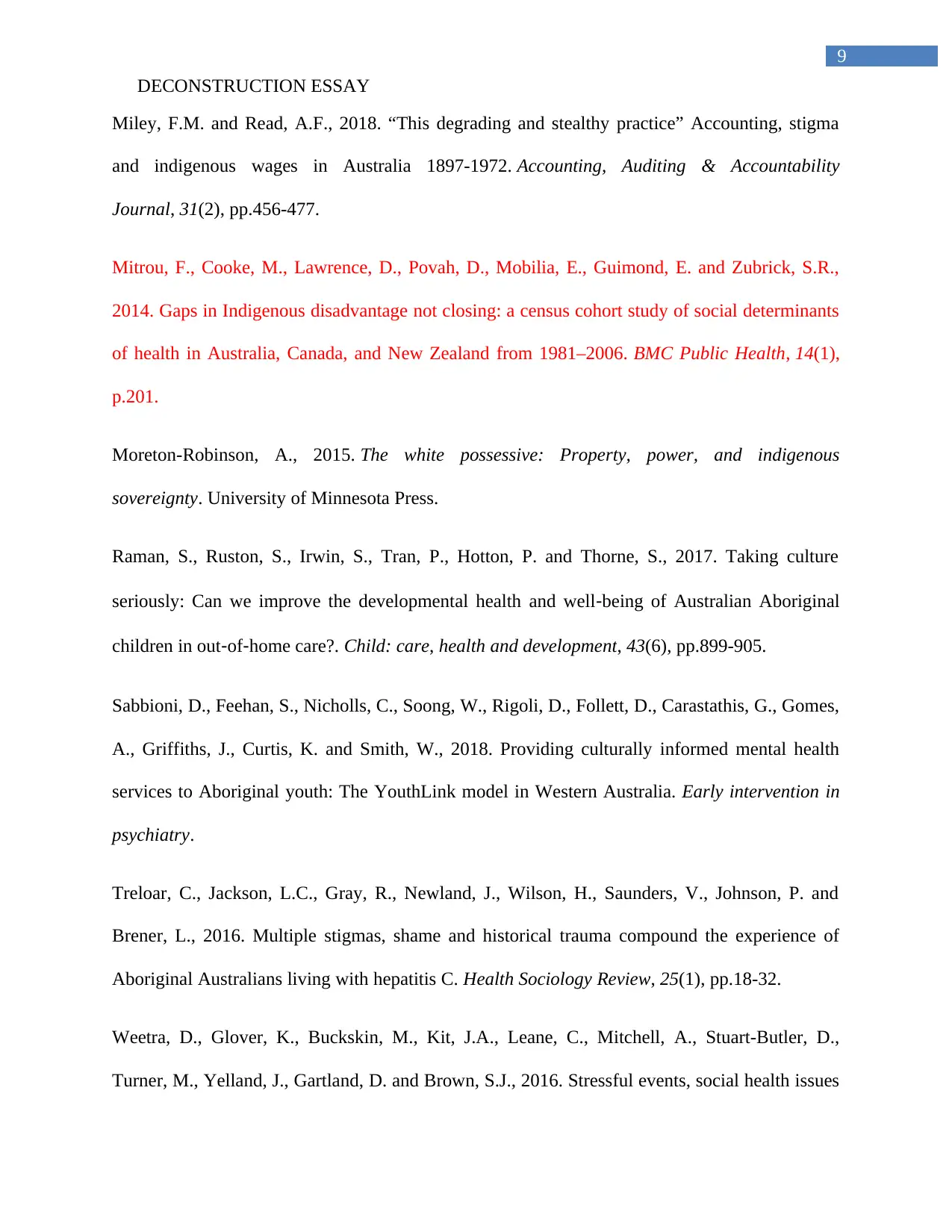
9
DECONSTRUCTION ESSAY
Miley, F.M. and Read, A.F., 2018. “This degrading and stealthy practice” Accounting, stigma
and indigenous wages in Australia 1897-1972. Accounting, Auditing & Accountability
Journal, 31(2), pp.456-477.
Mitrou, F., Cooke, M., Lawrence, D., Povah, D., Mobilia, E., Guimond, E. and Zubrick, S.R.,
2014. Gaps in Indigenous disadvantage not closing: a census cohort study of social determinants
of health in Australia, Canada, and New Zealand from 1981–2006. BMC Public Health, 14(1),
p.201.
Moreton-Robinson, A., 2015. The white possessive: Property, power, and indigenous
sovereignty. University of Minnesota Press.
Raman, S., Ruston, S., Irwin, S., Tran, P., Hotton, P. and Thorne, S., 2017. Taking culture
seriously: Can we improve the developmental health and well‐being of Australian Aboriginal
children in out‐of‐home care?. Child: care, health and development, 43(6), pp.899-905.
Sabbioni, D., Feehan, S., Nicholls, C., Soong, W., Rigoli, D., Follett, D., Carastathis, G., Gomes,
A., Griffiths, J., Curtis, K. and Smith, W., 2018. Providing culturally informed mental health
services to Aboriginal youth: The YouthLink model in Western Australia. Early intervention in
psychiatry.
Treloar, C., Jackson, L.C., Gray, R., Newland, J., Wilson, H., Saunders, V., Johnson, P. and
Brener, L., 2016. Multiple stigmas, shame and historical trauma compound the experience of
Aboriginal Australians living with hepatitis C. Health Sociology Review, 25(1), pp.18-32.
Weetra, D., Glover, K., Buckskin, M., Kit, J.A., Leane, C., Mitchell, A., Stuart-Butler, D.,
Turner, M., Yelland, J., Gartland, D. and Brown, S.J., 2016. Stressful events, social health issues
DECONSTRUCTION ESSAY
Miley, F.M. and Read, A.F., 2018. “This degrading and stealthy practice” Accounting, stigma
and indigenous wages in Australia 1897-1972. Accounting, Auditing & Accountability
Journal, 31(2), pp.456-477.
Mitrou, F., Cooke, M., Lawrence, D., Povah, D., Mobilia, E., Guimond, E. and Zubrick, S.R.,
2014. Gaps in Indigenous disadvantage not closing: a census cohort study of social determinants
of health in Australia, Canada, and New Zealand from 1981–2006. BMC Public Health, 14(1),
p.201.
Moreton-Robinson, A., 2015. The white possessive: Property, power, and indigenous
sovereignty. University of Minnesota Press.
Raman, S., Ruston, S., Irwin, S., Tran, P., Hotton, P. and Thorne, S., 2017. Taking culture
seriously: Can we improve the developmental health and well‐being of Australian Aboriginal
children in out‐of‐home care?. Child: care, health and development, 43(6), pp.899-905.
Sabbioni, D., Feehan, S., Nicholls, C., Soong, W., Rigoli, D., Follett, D., Carastathis, G., Gomes,
A., Griffiths, J., Curtis, K. and Smith, W., 2018. Providing culturally informed mental health
services to Aboriginal youth: The YouthLink model in Western Australia. Early intervention in
psychiatry.
Treloar, C., Jackson, L.C., Gray, R., Newland, J., Wilson, H., Saunders, V., Johnson, P. and
Brener, L., 2016. Multiple stigmas, shame and historical trauma compound the experience of
Aboriginal Australians living with hepatitis C. Health Sociology Review, 25(1), pp.18-32.
Weetra, D., Glover, K., Buckskin, M., Kit, J.A., Leane, C., Mitchell, A., Stuart-Butler, D.,
Turner, M., Yelland, J., Gartland, D. and Brown, S.J., 2016. Stressful events, social health issues
Paraphrase This Document
Need a fresh take? Get an instant paraphrase of this document with our AI Paraphraser
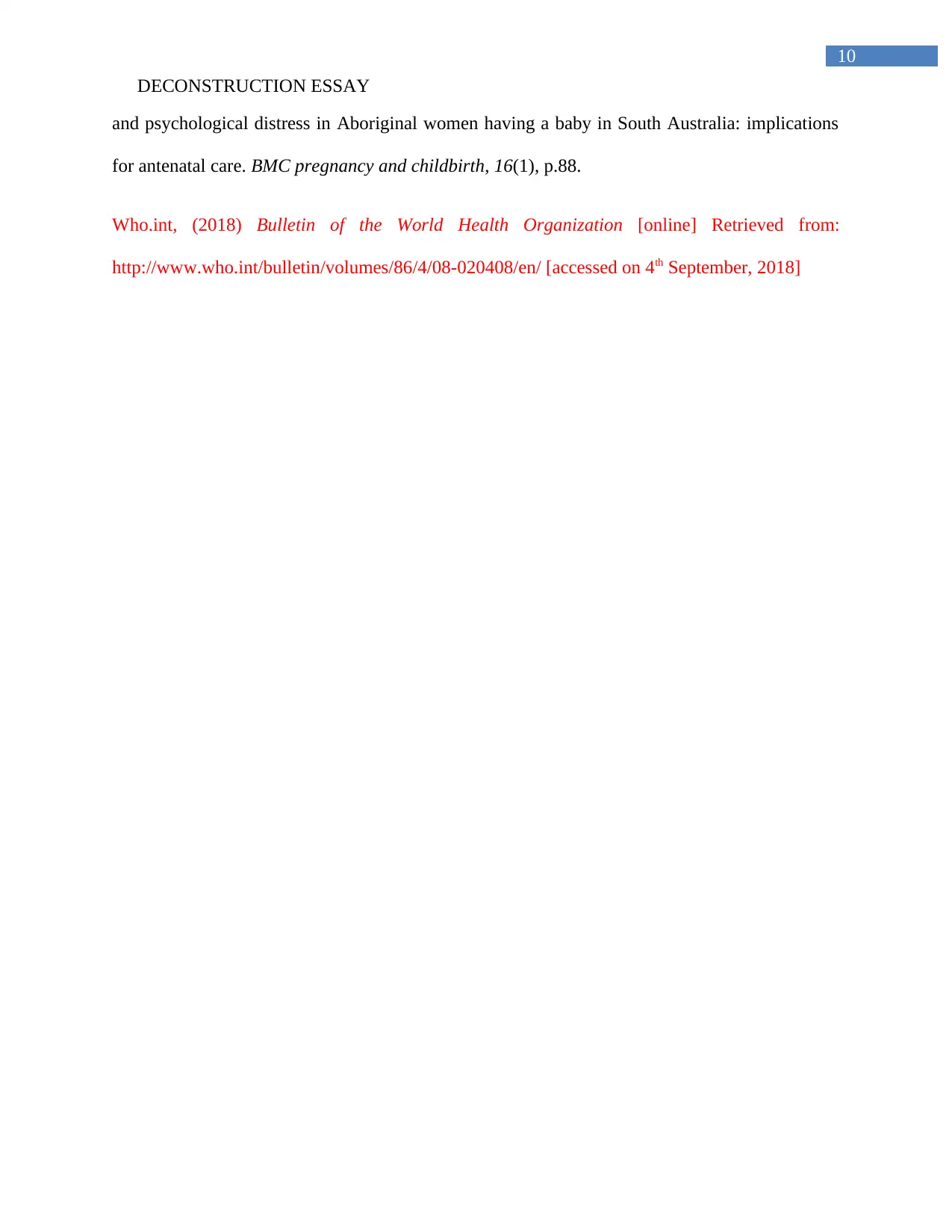
10
DECONSTRUCTION ESSAY
and psychological distress in Aboriginal women having a baby in South Australia: implications
for antenatal care. BMC pregnancy and childbirth, 16(1), p.88.
Who.int, (2018) Bulletin of the World Health Organization [online] Retrieved from:
http://www.who.int/bulletin/volumes/86/4/08-020408/en/ [accessed on 4th September, 2018]
DECONSTRUCTION ESSAY
and psychological distress in Aboriginal women having a baby in South Australia: implications
for antenatal care. BMC pregnancy and childbirth, 16(1), p.88.
Who.int, (2018) Bulletin of the World Health Organization [online] Retrieved from:
http://www.who.int/bulletin/volumes/86/4/08-020408/en/ [accessed on 4th September, 2018]
1 out of 11
Related Documents
Your All-in-One AI-Powered Toolkit for Academic Success.
+13062052269
info@desklib.com
Available 24*7 on WhatsApp / Email
![[object Object]](/_next/static/media/star-bottom.7253800d.svg)
Unlock your academic potential
Copyright © 2020–2025 A2Z Services. All Rights Reserved. Developed and managed by ZUCOL.





